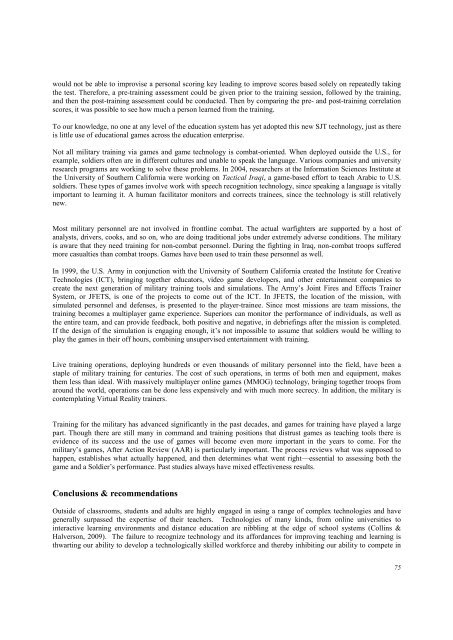Download Complete Issue in PDF - Educational Technology & Society
Download Complete Issue in PDF - Educational Technology & Society
Download Complete Issue in PDF - Educational Technology & Society
Create successful ePaper yourself
Turn your PDF publications into a flip-book with our unique Google optimized e-Paper software.
would not be able to improvise a personal scor<strong>in</strong>g key lead<strong>in</strong>g to improve scores based solely on repeatedly tak<strong>in</strong>g<br />
the test. Therefore, a pre-tra<strong>in</strong><strong>in</strong>g assessment could be given prior to the tra<strong>in</strong><strong>in</strong>g session, followed by the tra<strong>in</strong><strong>in</strong>g,<br />
and then the post-tra<strong>in</strong><strong>in</strong>g assessment could be conducted. Then by compar<strong>in</strong>g the pre- and post-tra<strong>in</strong><strong>in</strong>g correlation<br />
scores, it was possible to see how much a person learned from the tra<strong>in</strong><strong>in</strong>g.<br />
To our knowledge, no one at any level of the education system has yet adopted this new SJT technology, just as there<br />
is little use of educational games across the education enterprise.<br />
Not all military tra<strong>in</strong><strong>in</strong>g via games and game technology is combat-oriented. When deployed outside the U.S., for<br />
example, soldiers often are <strong>in</strong> different cultures and unable to speak the language. Various companies and university<br />
research programs are work<strong>in</strong>g to solve these problems. In 2004, researchers at the Information Sciences Institute at<br />
the University of Southern California were work<strong>in</strong>g on Tactical Iraqi, a game-based effort to teach Arabic to U.S.<br />
soldiers. These types of games <strong>in</strong>volve work with speech recognition technology, s<strong>in</strong>ce speak<strong>in</strong>g a language is vitally<br />
important to learn<strong>in</strong>g it. A human facilitator monitors and corrects tra<strong>in</strong>ees, s<strong>in</strong>ce the technology is still relatively<br />
new.<br />
Most military personnel are not <strong>in</strong>volved <strong>in</strong> frontl<strong>in</strong>e combat. The actual warfighters are supported by a host of<br />
analysts, drivers, cooks, and so on, who are do<strong>in</strong>g traditional jobs under extremely adverse conditions. The military<br />
is aware that they need tra<strong>in</strong><strong>in</strong>g for non-combat personnel. Dur<strong>in</strong>g the fight<strong>in</strong>g <strong>in</strong> Iraq, non-combat troops suffered<br />
more casualties than combat troops. Games have been used to tra<strong>in</strong> these personnel as well.<br />
In 1999, the U.S. Army <strong>in</strong> conjunction with the University of Southern California created the Institute for Creative<br />
Technologies (ICT), br<strong>in</strong>g<strong>in</strong>g together educators, video game developers, and other enterta<strong>in</strong>ment companies to<br />
create the next generation of military tra<strong>in</strong><strong>in</strong>g tools and simulations. The Army’s Jo<strong>in</strong>t Fires and Effects Tra<strong>in</strong>er<br />
System, or JFETS, is one of the projects to come out of the ICT. In JFETS, the location of the mission, with<br />
simulated personnel and defenses, is presented to the player-tra<strong>in</strong>ee. S<strong>in</strong>ce most missions are team missions, the<br />
tra<strong>in</strong><strong>in</strong>g becomes a multiplayer game experience. Superiors can monitor the performance of <strong>in</strong>dividuals, as well as<br />
the entire team, and can provide feedback, both positive and negative, <strong>in</strong> debrief<strong>in</strong>gs after the mission is completed.<br />
If the design of the simulation is engag<strong>in</strong>g enough, it’s not impossible to assume that soldiers would be will<strong>in</strong>g to<br />
play the games <strong>in</strong> their off hours, comb<strong>in</strong><strong>in</strong>g unsupervised enterta<strong>in</strong>ment with tra<strong>in</strong><strong>in</strong>g.<br />
Live tra<strong>in</strong><strong>in</strong>g operations, deploy<strong>in</strong>g hundreds or even thousands of military personnel <strong>in</strong>to the field, have been a<br />
staple of military tra<strong>in</strong><strong>in</strong>g for centuries. The cost of such operations, <strong>in</strong> terms of both men and equipment, makes<br />
them less than ideal. With massively multiplayer onl<strong>in</strong>e games (MMOG) technology, br<strong>in</strong>g<strong>in</strong>g together troops from<br />
around the world, operations can be done less expensively and with much more secrecy. In addition, the military is<br />
contemplat<strong>in</strong>g Virtual Reality tra<strong>in</strong>ers.<br />
Tra<strong>in</strong><strong>in</strong>g for the military has advanced significantly <strong>in</strong> the past decades, and games for tra<strong>in</strong><strong>in</strong>g have played a large<br />
part. Though there are still many <strong>in</strong> command and tra<strong>in</strong><strong>in</strong>g positions that distrust games as teach<strong>in</strong>g tools there is<br />
evidence of its success and the use of games will become even more important <strong>in</strong> the years to come. For the<br />
military’s games, After Action Review (AAR) is particularly important. The process reviews what was supposed to<br />
happen, establishes what actually happened, and then determ<strong>in</strong>es what went right—essential to assess<strong>in</strong>g both the<br />
game and a Soldier’s performance. Past studies always have mixed effectiveness results.<br />
Conclusions & recommendations<br />
Outside of classrooms, students and adults are highly engaged <strong>in</strong> us<strong>in</strong>g a range of complex technologies and have<br />
generally surpassed the expertise of their teachers. Technologies of many k<strong>in</strong>ds, from onl<strong>in</strong>e universities to<br />
<strong>in</strong>teractive learn<strong>in</strong>g environments and distance education are nibbl<strong>in</strong>g at the edge of school systems (Coll<strong>in</strong>s &<br />
Halverson, 2009). The failure to recognize technology and its affordances for improv<strong>in</strong>g teach<strong>in</strong>g and learn<strong>in</strong>g is<br />
thwart<strong>in</strong>g our ability to develop a technologically skilled workforce and thereby <strong>in</strong>hibit<strong>in</strong>g our ability to compete <strong>in</strong><br />
75

















